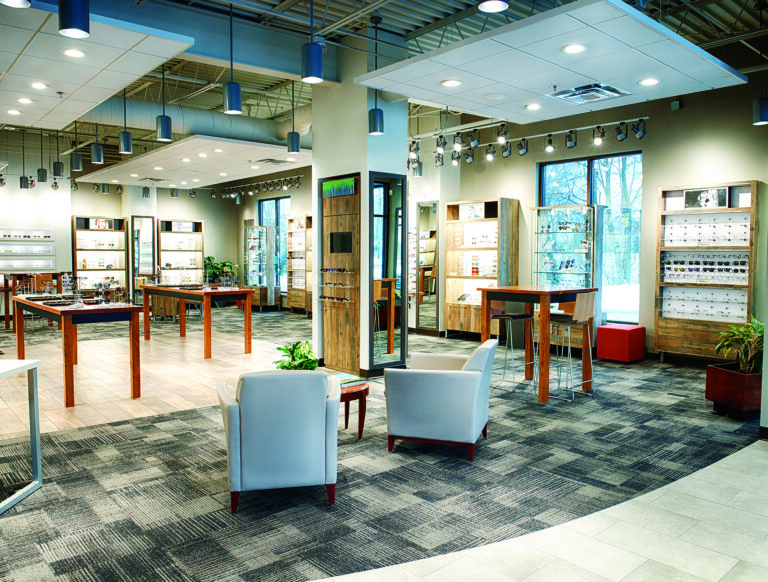By Andrew Fader, Eye Designs, LLC
Originally published in Review of Optometric Business
The eyecare industry is in the business of helping people see better. Yet, ironically, one of its biggest flaws is poorly lit practices. Too often, we see poor illumination throughout the retail optical area, on frame boards, examination rooms and other office areas.
Often, practices have lights that are burnt out, flickering and not operating properly. Poor lighting makes it harder for people to see.
Using proper lighting on your frame inventory will better highlight your product mix and showcase all the design details and unique colors of your frame collections. Here are some of the most common lighting missteps, along with information about what you should do instead to make better choices.


LIGHTING THE OPTICAL LIKE THE BACK OFFICE
Optical dispensaries and displays are typically under-lit. Lighting plans for practice build-outs too often treat the optical dispensary the same as the back office, utilizing volumetric 2×2 or 2×4 generic light fixtures to illuminate the space. However, lighting should be specific to each part of the office, especially targeted lighting to promote a retail environment, product enhancement and ease of patient interaction.
USING LIGHTING THAT MUTES YOUR FRAMES’ COLORS
One of the biggest lighting challenges is determining the proper color temperature (Kelvin/K) and the proper Color Rendering Index (CRI) levels. Most contractors, electricians and architects specify standard, commonly found products that skew to a yellowish hue (3000K) and make your frames look muted with a low color rendering index (80CRI).
USING THE WRONG LUMEN OUTPUT
Most under-lit situations can be fixed by increasing the number of lights in the area and the lumen output. Lumen output indicates how powerful the light fixtures are when used to illuminate an area. Many optical locations, display lighting and track system lumen outputs are too low, which results in an office that looks dull and under-lit. When you have higher ceilings, you need to make sure you increase the lumen output of your product since the light being generated by the fixture needs to travel a longer distance.
USING AN INCOMPATIBLE DIMMER SWITCH
Not all LED products are dimmable. It is highly recommended when installing LED products that you ensure you can control the lights properly, especially in the exam room and pretesting areas. The most common mistake is when people convert to LED products, they still have the old dimmer switch installed, and most LED products are incompatible. The result is a strobe-light effect, which doesn’t dim all the way down, or doesn’t dim at all. Most lighting manufacturers will list all compatible dimmers on the lights’ specification sheet or website.
LIGHTING MIRRORS INCORRECTLY
Most retail optical areas have wall-hung mirrors for patients who are browsing and trying on eyewear, but they do not illuminate these mirrors correctly. Many don’t illuminate areas where these mirrors are at all and some only put a standard down-light that creates shadows on the face of the person trying on the frame. The correct way to illuminate a wall mirror is to place a directional down-light closer to the mirror and angle the light off the mirror onto the customer. This makes for a better patient viewing experience.
POOR LIGHTING IN TRANSACTION AREAS
Patients interact with your reception staff, optician, technicians and contact-lens training staff in critical areas of your office environments. Often, the areas where these interactions occur are poorly lit. Areas like the reception desk have pendant lights that are purely decorative and do not provide enough general lighting for customers checking in and out.
Additional Points to Keep in Mind to Do It Right
BENEFIT OF LEDS
Energy regulations and cost have drastically changed in recent years. Moving to LED fixtures helps lower your overall energy footprint and lower your monthly energy bills. Unlike traditional incandescent bulbs and fixtures, LED efficiency can reduce usage by 50 percent or more.
Small investments in new LED lighting can make a dramatic difference to the overall look and feel of your practice. Changing from the standard yellowish warm light of traditional incandescent bulbs or harsh florescent light to crisp neutral white (4000K) LED will create an environment that feels brighter, more energetic and inviting.
Read the full original story from Review of Optometric Business here.
To read more design inspiration stories from WO, click here.



